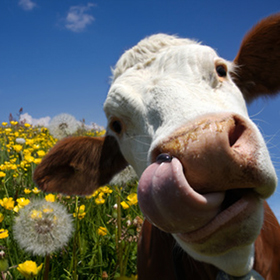Wine Industry Battles ‘Silent But Deadly’ Gas Emissions
 In the aftermath of Auction Napa Valley’s annual charitable fundraiser it’s clear that those in the wine industry are seriously invested in helping their fellow man. Some in the trade go further than others in their mission to make the world a better place for our children, in their quest to preserve our precious natural resources, or in their resounding commitment to save the world from cow flatulence.
In the aftermath of Auction Napa Valley’s annual charitable fundraiser it’s clear that those in the wine industry are seriously invested in helping their fellow man. Some in the trade go further than others in their mission to make the world a better place for our children, in their quest to preserve our precious natural resources, or in their resounding commitment to save the world from cow flatulence.
There are many serious threats to the future of mankind and paramount among these are global warming, worldwide pandemic and insipid Pinot Grigio. While the wine industry is powerless in the fight against frightening new diseases and wishy-washy wine, there are some winemakers who are partnering with agricultural concerns to combat global warming.
According to the Environmental Protection Agency (EPA), the second most prevalent greenhouse gas emitted by human activities in the United States is Methane (CH4). The greenhouse gas Carbon Dioxide (CO2) refuses to give up its coveted number one position but the EPA reports that Methane “is more efficient at trapping radiation than CO2. Pound for pound, the comparative impact of CH4 on climate change is more than 25 times greater than CO2 over a 100-year period.”¹ So where does Methane gas come from? You probably think this malicious gas comes from the petroleum, natural gas, and coal industries, and of course you’d be right.
On a global scale however, agriculture is the largest source of Methane gas production and I don’t mean it comes from the fertilizer industry or some other agro-related chemical conglomerate. No, Methane gas emissions come from anaerobic fermentation of endogenous and exogenous carbohydrates by enteric microflora; or what I like to call – animal farts.
The worst offenders are cows, buffalo, sheep, goats, camels, and my brother-in-law, who always blames the dog. The fact of the matter is the petroleum, natural gas, and agriculture industries all contribute to methane gas production, and when it comes to noxious gas emissions the wine trade is trying to cut one.
Grape marc (the pomace of grape skins, pulp, seeds, and stems that remain after pressing) has long been used as a livestock feed supplement but recent studies have shown that it can reduce Methane gas in the digestive system of sheep and cattle.
In a Journal of Dairy Science report, P.J. Moate wrote, “Grape marc contains condensed tannins and has high concentrations of crude fat; both these substances can reduce enteric methane (CH4) production when fed to ruminants.”²
Of course this raises a critical question; what the heck is a ruminant?
I had to look it up and found a ruminant is “an even-toed ungulate mammal that chews the cud regurgitated from its rumen” (its first stomach), which is funnier than anything I could think up on my own.
When wine and agriculture professionals caught wind of these findings they began developing viable nutritional strategies for ruminants that just might result in a serious reduction in the greenhouse effect. This raises yet another critical question; given the source of methane gas emissions, shouldn’t the greenhouse effect be called the outhouse effect?
If successful, millions of tons of marc could be converted into livestock food supplements that in turn, could significantly reduce the amount of methane gas released into the atmosphere. The dairy industry alone could cut substantial gas emissions without having to cut the cheese production.
Moate goes on to report, “the use of grape marc together with other methane reducing feeds could result in a reduction in methane emissions of up to 20,000 tonnes per year – the equivalent of taking about 200,000 cars off the road.” The study concludes that, “the important and novel finding of this research was that the feeding of both DGM [dried, pelleted grape marc] and EGM [ensiled grape marc] to dairy cows in late lactation reduced CH4 emissions by approximately 20%.”²
Methane inhibiting feed supplements for livestock have been thoroughly studied which means cows breaking wind isn’t exactly breaking news. The extensive published findings do more than suggest the Journal of Dairy Science report passes the smell test; they suggest that if the wine and agriculture industries work together on reducing greenhouse gases, someday we may all breathe a little easier.
¹ Overview of Greenhouse Gases. EPA United States Environmental Protection Agency. https://www3.epa.gov/climatechange/ghgemissions/gases/ch4.html
² P.J. Moate, S.R.O. Williams, V.A. Torok, M.C. Hannah, B.E. Ribaux, M.H. Tavendale, R.J. Eckard, J.L. Jacobs, M.J. Auldist, W.J. Wales. Grape marc reduces methane emissions when fed to dairy cows. Journal of Dairy Science. August 2014 Volume 97, Issue 8, Pages 5073–5087. http://www.journalofdairyscience.org/article/S0022-0302(14)00430-5/fulltext#sec0085






















